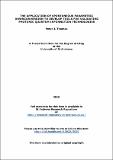Files in this item
The application of spontaneous parametric downconversion to develop tools for validating photonic quantum information technologies
Item metadata
| dc.contributor.advisor | Dunn, Malcolm H. | |
| dc.contributor.advisor | Chunnilall, Christopher | |
| dc.contributor.author | Thomas, Peter James | |
| dc.coverage.spatial | 231 | en_US |
| dc.date.accessioned | 2012-08-17T14:29:19Z | |
| dc.date.available | 2012-08-17T14:29:19Z | |
| dc.date.issued | 2010-11-30 | |
| dc.identifier | uk.bl.ethos.555584 | |
| dc.identifier.uri | https://hdl.handle.net/10023/3050 | |
| dc.description.abstract | This portfolio of work contributes to the remit of the National Physical Laboratory (NPL) to develop the underpinning expertise and tools for validating nascent and future optical quantum technologies based on the discrete and quantum properties of photons. This requirement overlaps with the requirement to provide validation for devices operating in the photon-counting regime. A common theme running through the portfolio is photon pairs generated through spontaneous parametric downconversion (SPDC). A Hong-Ou-Mandel (HOM) interferometer sourced with visible wavelength photon pairs from an SPDC process in beta-barium borate (BBO) was designed, built and characterised. The visibility of the HOM interference is dependent on the indistinguishability of the interfering photons, but is also influenced by imperfections of the interferometer; therefore an investigation was carried out to quantify the effects of the interferometer imperfections on the measured visibility so that the true photon indistinguishability could be measured with a quantified uncertainty. A bright source of correlated pair photons in the telecoms band based upon a pump enhanced SPDC process in periodically-poled potassium titanyl phosphate (PPKTP) was designed, built and characterised. From the characterisation measurements the source brightness was estimated to be 6.2×10⁴ pairs/ s/ mw pump. The photon pairs were further characterised through their incorporation as a source in a HOM interference experiment. The developed correlated photon pair source was at the heart of a novel scheme for the generation of polarisation entangled photon pairs, for which the design, build and characterisation work is presented. The source was demonstrated to produce two of the four maximally entangled Bell states with quantum interference visibilities of around 0.95. The generated states were also shown to break a form of Bell’s inequality by around six standard deviations. The polarisation entangled photon pair source was originally built at the University of St Andrews and was later transferred to the NPL where it will extend NPL’s capabilities to this key spectral region. Finally a study was carried out to investigate the possibility of a wavelength tuneable device for the absolute measurement of single photon detector quantum efficiencies based upon an established SPDC technique. | en_US |
| dc.language.iso | en | en_US |
| dc.publisher | University of St Andrews | |
| dc.subject | SPDC | en_US |
| dc.subject | Hong-Ou-Mandel | en_US |
| dc.subject | Nonlinear optics | en_US |
| dc.subject | Entanglement | en_US |
| dc.subject | Few photon | en_US |
| dc.subject.lcc | QC446.2T5 | |
| dc.subject.lcsh | Nonlinear optics | en_US |
| dc.subject.lcsh | Quantum optics | en_US |
| dc.subject.lcsh | Photons | en_US |
| dc.subject.lcsh | Quantum interference | en_US |
| dc.title | The application of spontaneous parametric downconversion to develop tools for validating photonic quantum information technologies | en_US |
| dc.type | Thesis | en_US |
| dc.type.qualificationlevel | Doctoral | en_US |
| dc.type.qualificationname | DEng Doctor of Engineering | en_US |
| dc.publisher.institution | The University of St Andrews | en_US |
This item appears in the following Collection(s)
Items in the St Andrews Research Repository are protected by copyright, with all rights reserved, unless otherwise indicated.

